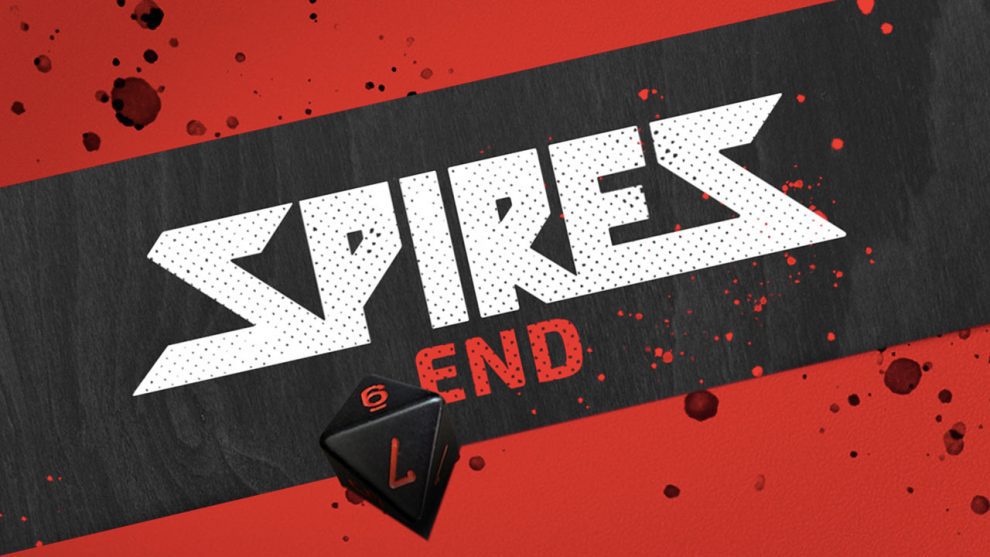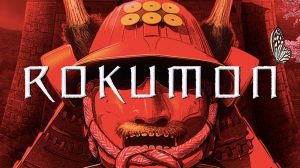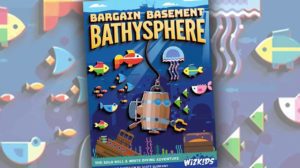Disclosure: Meeple Mountain received a free copy of this product in exchange for an honest, unbiased review. This review is not intended to be an endorsement.
Spire’s End is billed as a dungeon-crawling solo or co-op Choose Your Own Adventure escapade packaged neatly into a deck of cards, and that’s a pretty apt reference point. For those who aren’t familiar, the Choose Your Own Adventure books were a collection of interactive novels that centered the reader as the hero of each story. As each book went on, the reader would be asked to make choices about what s/he would do, flipping to the corresponding numbered page to find out what the results of that choice were, which would lead to another set of decisions, and so forth. The result is that each reading of the book followed its own distinct path, branching and unfolding based on the whims of the reader.
While the CYOA books were quite good on their own, Joe Dever’s Lone Wolf series and the Fighting Fantasy titles took the interactive novel a step further by incorporating a number of RPG-like features such as character sheets, special abilities, and combat encounters that had to be played out by the reader to survive and advance the plot. Essentially, these books provided a single-player RPG experience, and part of the fun was playing through them over and over to figure out the best path through the variety of obstacles and decision points they contained.
Spire’s End pillages the basic framework of the interactive fantasy novel, tears the books apart to build a deck of cards, splatters each card with art that’s equal parts comic book and grindhouse, crowds its world with bizarre and grotesque creatures, and then dares players to successfully escape its macabre meatgrinder of combat. It’s stylish, it’s sleek, and it’s unlike anything on the market at the moment. But is that enough?
A Deck of Many Things
The box for Spire’s End contains three 8-sided dice (one red and two black), a few handfuls of colored cubes, some numbered tiles, and a deck of cards. That’s it. If you’re looking for a rulebook, you’ll be sorely disappointed. This game doesn’t have one.
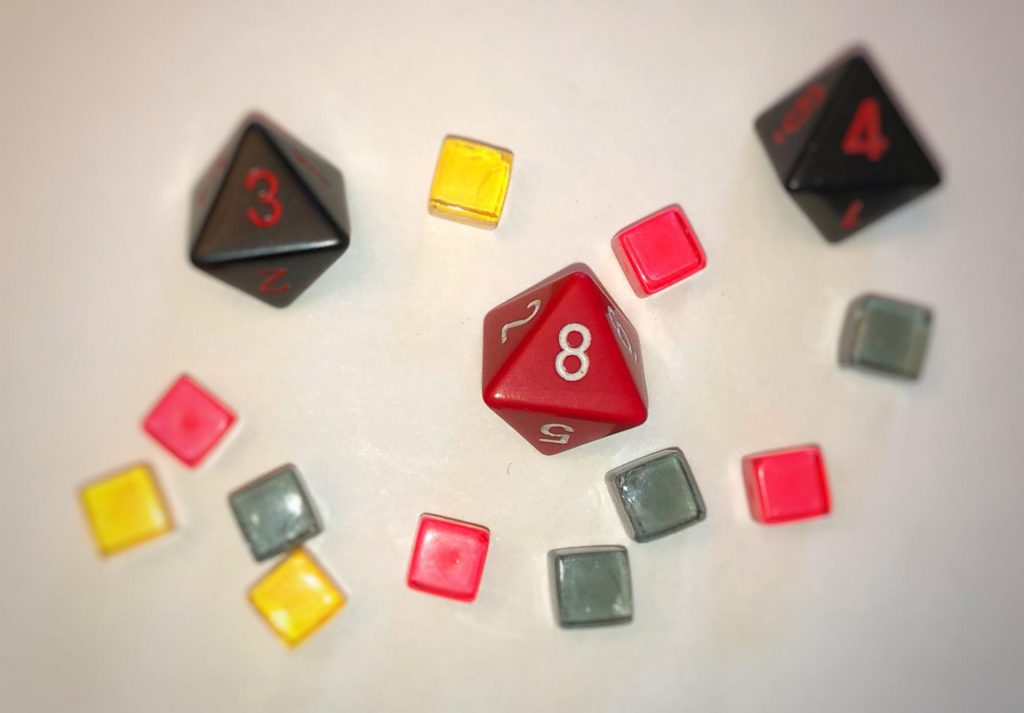
What it does have is that lovely-looking deck of cards. Once you’ve sifted the cubes through your fingers and kissed the dice for good luck, you’ll be flipping the top card of the deck, which will direct you on to the next card, and so forth. Occasionally, a card will present you with a choice between multiple options. Whichever option you pick leads you to another card further down the deck; the cards between are discarded, never to be seen again in that playthrough. Just as with other interactive media, there’s a potent lure to those lost options, making you want to play through the game again just to learn what you missed.

And there are a lot of cards to see! One of the cleverest elements of Spire’s End is how every piece of game information — the rules, the stats, the story, everything — is presented through the deck. There’s never a need to consult an unwieldy rulebook or chart to see what should happen next. As a result, the first few cards serve as a tutorial and an introduction to the setting, explaining the basics of the game before dropping you into your first combat.
Round One, Fight!
Combat occupies a large portion of Spire’s End, but thankfully it’s not hard to understand at the most basic level. At any given point you will have 2 Ally cards (your characters, essentially) in play, each with their own hit point (HP) and armor point totals as well as several special abilities. These abilities cost between 0 and 4 HP to use, with higher costs granting you better odds of success, more dealt damage, or more powerful status effects to help your team or hinder your enemies.
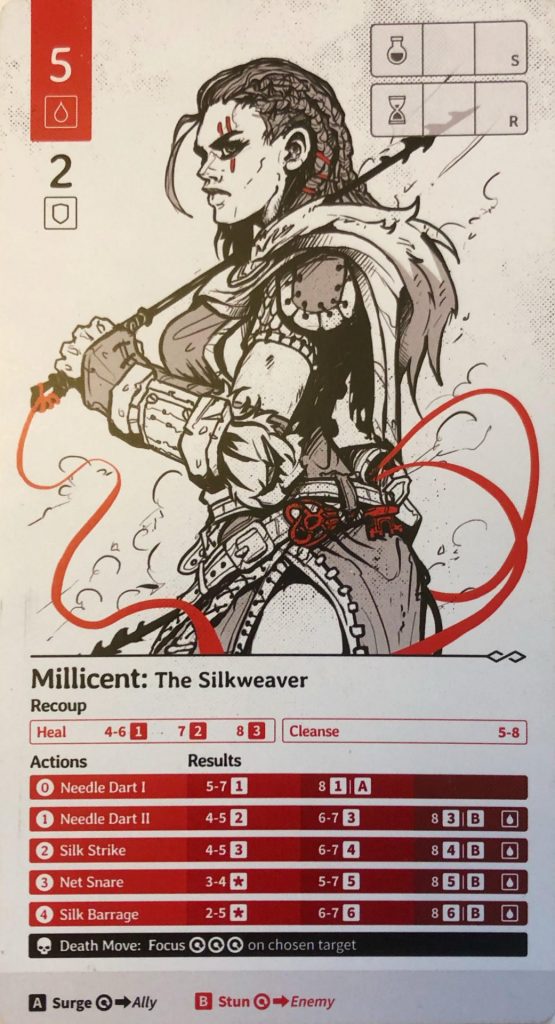
Taking a turn with your first Ally requires you to choose an ability, pay the cost, and then roll a die to determine what happens. Once that action is resolved, that Ally gets a chance to Recoup, allowing them to potentially heal up lost HP, shake off negative status effects, or otherwise gain an advantage. Finally, there’s an Upkeep step which resolves any pending status effects. Once the first Ally has acted, the second Ally goes through the same three steps.
Lastly, the enemy gets a chance to act, flipping the top tile from the stack of numbered tiles. This determines which of their powers they’ll use, and a roll of the die determines which Ally gets targeted. After the enemy Recoup and Upkeep steps, which are similar to the Allies’, a new round of combat starts again. If an Ally dies, they are replaced by a new one from a deck of 7 and the fight continues. Most of the encounters end when the enemy dies; however, some of the encounters have interesting alternate ending conditions that can cause a battle to end prematurely. Should all 7 Allies perish, the game ends.
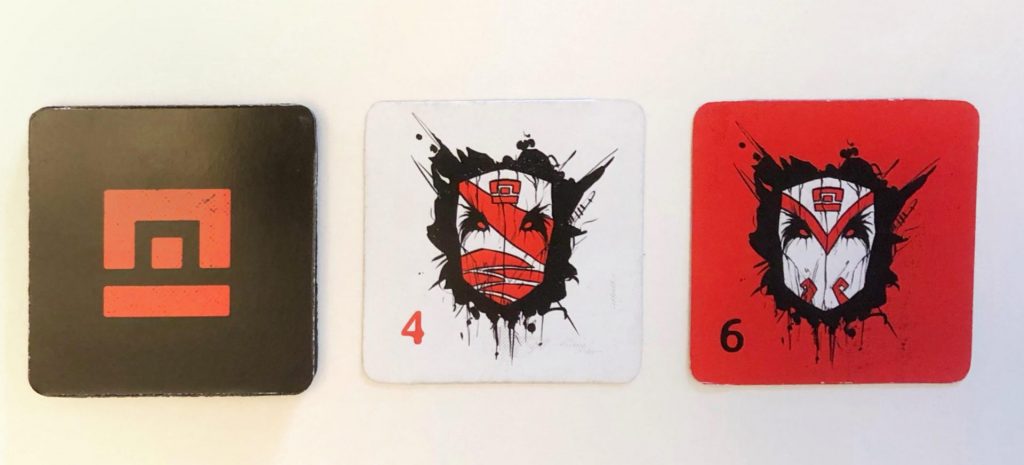
Playing Fast and Loose
Anyone familiar with tactical RPGs will immediately feel at home with this system. It’s very reminiscent of the 4th edition of Dungeons & Dragons, though drastically simplified: there are no rules for movement or distance, for example. The upshot of that simplification is that it plays quite quickly. A full round of combat can be completed in a minute or less, and combats rarely stretch past 6 or 7 rounds. There’s a pleasant churn of moving cubes and rolling dice, as well as some really fantastic narrative moments that emerge because of the system’s flexibility and ease of intuition.
The flipside is that, while the action can be intense and occasionally quite challenging, it isn’t as mechanically tight as it could be. There are a few gaps in the rules, mostly to do with timing and how various abilities interact with certain status effects. Being a solo game, it’s not much of a problem for players to simply make a ruling and move on; however, it does mean that challenge level may vary wildly from game to game. In later combats, which can become quite punishing, some of those issues might be seriously problematic, so hopefully they’ll be cleaned up before the final release.
Black and White and Red All Over
Of course, you may forget completely about the combat in Spire’s End because you’re too busy staring at the engrossingly gorgeous art. Few games out there today can match the aesthetic found in this box. Using mostly clean, sharp lines and a limited color palette of black, white, and red, Spire’s End has a distinct look that catches the eye. If the game play takes the Choose Your Own Adventure format and breaks it apart in order to improve it, then the art design does the same thing to Frank Miller’s Sin City, and the result is a beautifully grim fairytale.
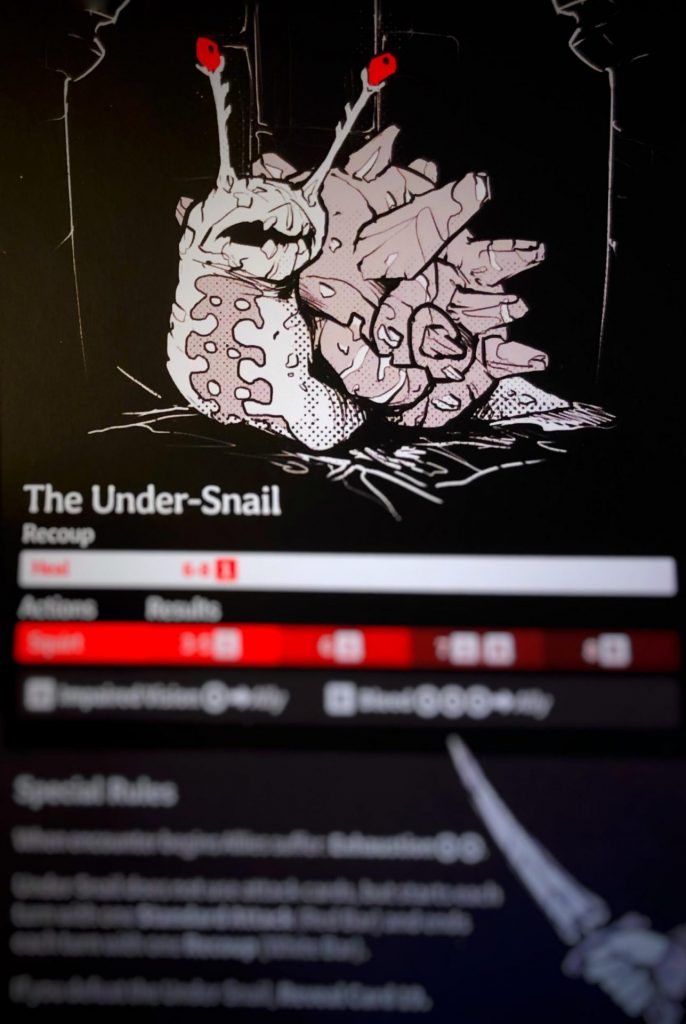
The graphic design is also incredibly thoughtful. Because all important information in the game is laid out on cards, those cards can occasionally be very dense; however, none of the cards are actually that difficult to read after the first few. Iconography is sparing enough to be helpful, yet frequent enough to memorize. There are several small touches that are particularly nice: for example, the main deck is separated into chapters, with each chapter designated by a different colored insignia. This allows the player to easily and quickly separate the chapters.
However, it should be noted that the art direction is definitely geared toward mature audiences. Combat in this game can be brutal, and the illustrations don’t shy away from visceral representations of that brutality. That doesn’t mean it’s all grotesque. Some of the monsters are, well, kinda….cute. However, if you’re squeamish about blood and guts or easily creeped out by fantasy-horror, Spire’s End may push you out of your comfort zone.

In-Spire-d Yet?
Should you back Spire’s End? The answer is a tentative “yes”. Spire’s End is truly a feast for the eyes, the world it builds is both disturbing and intriguing, and the core game experience is unique enough to make it worth owning. It certainly isn’t for everyone, but if you’re looking for a light tactical experience and can appreciate the theme/art, Spire’s End will certainly earn a place on your shelf.
Spire’s End Part 1 is currently on Kickstarter.


